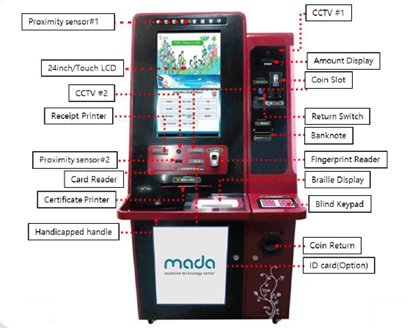Accessible Kiosk as an e-Government Service: Feedback from Persons with Physical Disabilities and Visual Impairments
Research article  Open access |
Available online on: 20 January, 2020 |
Last update: 28 October, 2021
Open access |
Available online on: 20 January, 2020 |
Last update: 28 October, 2021
 An accessible and well-designed kiosk can offer an efficient and autonomous experience for all users. From metro stations to government offices, the use of kiosk machines is widespread as a convenience and an alternative to human service. Until recently, an Automated Teller Machine (ATM) was the only form of a kiosk a person might need to use. It is now common to find public service functions completed through kiosks. As the use of kiosks grows, so does the need to ensure they are accessible and usable for all people, including those with disabilities.
An accessible and well-designed kiosk can offer an efficient and autonomous experience for all users. From metro stations to government offices, the use of kiosk machines is widespread as a convenience and an alternative to human service. Until recently, an Automated Teller Machine (ATM) was the only form of a kiosk a person might need to use. It is now common to find public service functions completed through kiosks. As the use of kiosks grows, so does the need to ensure they are accessible and usable for all people, including those with disabilities.
During QITCOM 2019, Mada collaborated with DOT incorporation in presenting the first fully accessible eGovernment kiosk. The four-day long conference attracted many decision-makers, disabled users, and stakeholders to explore the vast options and features of the eGovernment kiosk. Until recent times, an accessible kiosk was considered a kiosk with an additional keypad to make it accessible or made to wheelchair accessible height. Mada presented a comprehensive set of cross-disability interface techniques or strategies kiosk that extend to a touchscreen interface, braille input, audio output, wheelchair accessible; making it accessible to people with visual, physical, and cognitive disabilities.
The solution presented is an all-in-one fully accessible eGovernment kiosk for people with functional limitations. The All-in-One Kiosk provides government services such as issuing a license or certifications without the need to go to any administrative offices. It is an electronic device for implementing an advanced administrative system suitable for the digital information age, which is installed in an administrative institution or a public place to allow civilians to receive civil complaints directly.
DOT Incorporation closely studied the two main streams of accessible kiosks while developing and providing the major fusion of solutions for people with physical and visual disabilities. In general, the accessibility concerns relating to public kiosks fall into two broad streams:
- Kiosk environment and structure: This includes the location of the kiosk and providing ease of access for all people, including wheelchair users, the elderly, and people with impaired vision. It also covers the physical assembly of the kiosk, such as the height, angle of the screen and keyboard, provision of headphone outputs, and in some cases assistive keyboards.
- Screen interface:The size and color of the text and buttons on the screen, clear identification of form inputs, the usage of language that is easy to recognize, and provide audio alternatives for all information or functionality conveyed by images or text.
The physical structure of this kiosk and the environment in which it can be used are covered by government regulations regarding disability access to services in the built environment. Regarding the accessibility of the kiosk interface, the manufacturer has tried to stick to the limited regulations that are available such as WCAG, which appears to be a good starting point, particularly if the kiosk is providing access to online content such as government information, government services, and paid printing systems.
The following points were highlighted by various disabled users during the demo of the kiosks:
- All controls on the kiosk tactilely distinguishable
- Controls have braille and large print labels
- The height and spacing of the screen and controls appropriate for different types of users
- There is enough physical clearance around the machine for users with assistive mobility devices like a person using a wheelchair, scooter, or other mobility device has room to maneuver when approaching or leaving the machine from a side angle or front angle.
- User can receive braille and audio output (text to speech)
- Types of controls are needed to use the interface
- A physical keyboard along with a touch screen to enter text
- A person with a motor skills challenge may find it difficult to move their hand around a touch screen but may have no trouble using a trackball or touchpad pointer.
- Visual presentation of the interface can be customized like a visually impaired user can zoom in or out to change the size of the onscreen font
- The text-to-speech function activates when headphone is inserted into the jack
- The interface should always return to a default state after each user completes their tasks.
However, kiosk accessibility for the deaf and hard of hearing presents a unique problem for DOT Incorporation. To be fully compliant with the laws of accessibility, kiosks must offer equal communication access for deaf and hard of hearing individuals whose primary language is sign language. As they try to further improve the system, we hope to see these features added to support more users with diverse functional limitations.
